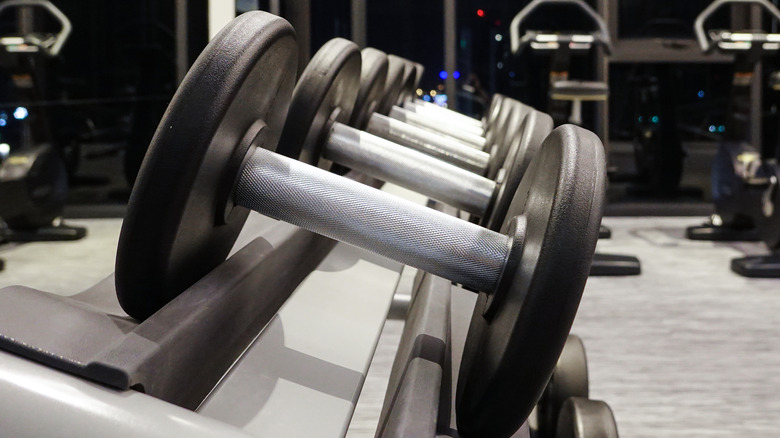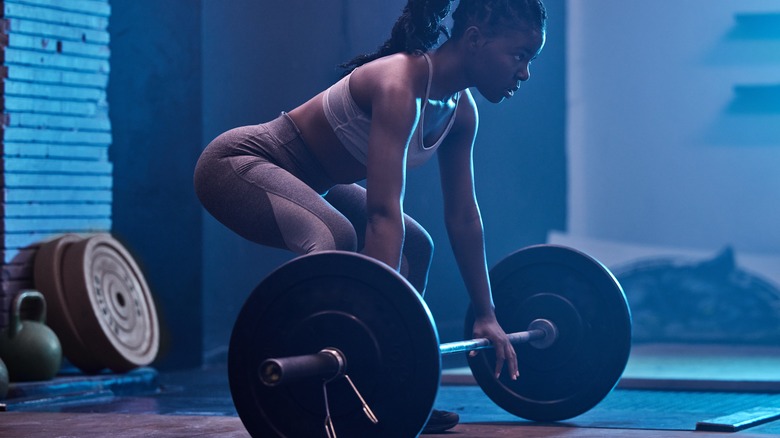Here's When You Should Use Light Weights Versus Heavy Weights
When you step into the gym, you have a choice — colored dumbbells or adding plates to a barbell. Strength training does wonders for the body and mind. According to Mayo Clinic, you can build lean body mass, which helps you lose weight. Strength training also protects your joints and helps with health conditions such as arthritis and depression. Hitting the weights might give your brain a boost, especially as you age.
The American Heart Association says health benefits come from training the major muscle groups at least twice a week on nonconsecutive days. Beginners should choose a weight heavy enough to lift for eight to 12 reps. But sometimes, you might want to mix it up according to your goals.
Strength training involves muscular hypotrophy, which is essentially when the muscle cells grow. There are two types of hypotrophy: myofibrillar and sarcoplasmic. Myofibrillar hypotrophy builds strength and speed, and sarcoplasmic is all about muscular endurance and glycogen storage (via Healthline). A 2016 study in the Journal of Applied Physiology found that muscular hypotrophy can be equal if you lift either light or heavy weights to failure. So the question remains — do you want power or endurance?
When to lift lighter weights
Muscle & Fitness suggests using lighter weights when you want to target specific muscles. For example, a triceps pressdown is supposed to recruit your triceps, but your shoulders kick in to do the work if the weight is too heavy. Lighter weights allow you to slow down the movement so that you're not using momentum to lift the weight.
Lighter weights are also best for those starting a weight training program or looking for muscular endurance (via Byrdie). They allow you to work the full range of motion while also building strength. A 2014 study in the Journal of Strength and Conditioning Research found that using a full range of motion during weight training had more significant changes in strength and decreases in body fat than people who worked a shorter range of motion. In other words, adding more weight at the expense of a shorter range of motion doesn't do much good.
If you're looking for muscular endurance, light weights are the way to go. A 2015 study in the Journal of Strength and Conditioning Research had one group lift lighter for 25 to 35 reps, and another group lifting heavy for the standard 8 to 12 reps. Although both groups gained equal amounts of muscle mass, the lighter-weight group had better muscular endurance in the upper body.
When to go heavy
Lifting heavy is all about power and explosiveness, and it's best when you want to perform better in running or jumping. A heavy weight is best for compound moves such as deadlifts or cleans, because they involve larger muscle groups that need more weight to fatigue (via Byrdie). You also get stronger much faster when lifting heavy weights (via Today).
A 2017 systematic review in the Journal of Strength and Conditioning Research found that lifting lighter vs. heavy weights involves muscle hypertrophy equally, but you'll get bigger strength gains if you lift heavy. Many weight lifting programs suggest lifting a weight for enough reps to get to failure, but that's not necessarily the case when you lift heavy. A 2022 study in the Journal of Strength and Conditioning Research found that lifting 80% of your one-rep-maximum weight for six reps still can build muscular strength.
It's always a good idea to change things up, because your body quickly adapts to your training (via Healthline). In other words, if you're used to lifting the lighter dumbbells for 25 to 30 reps in your workouts, your body might benefit from the shift to a heavier weight and fewer reps.



